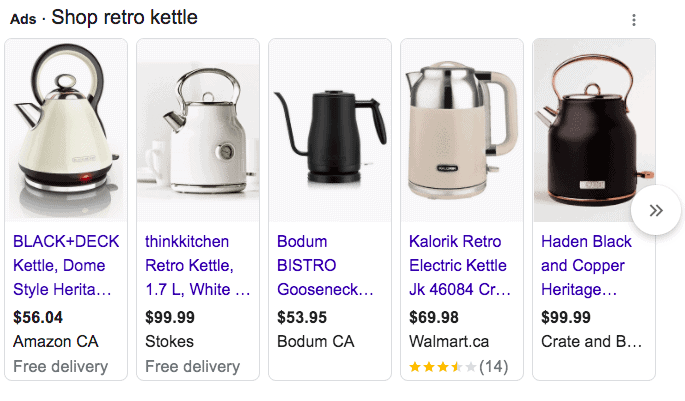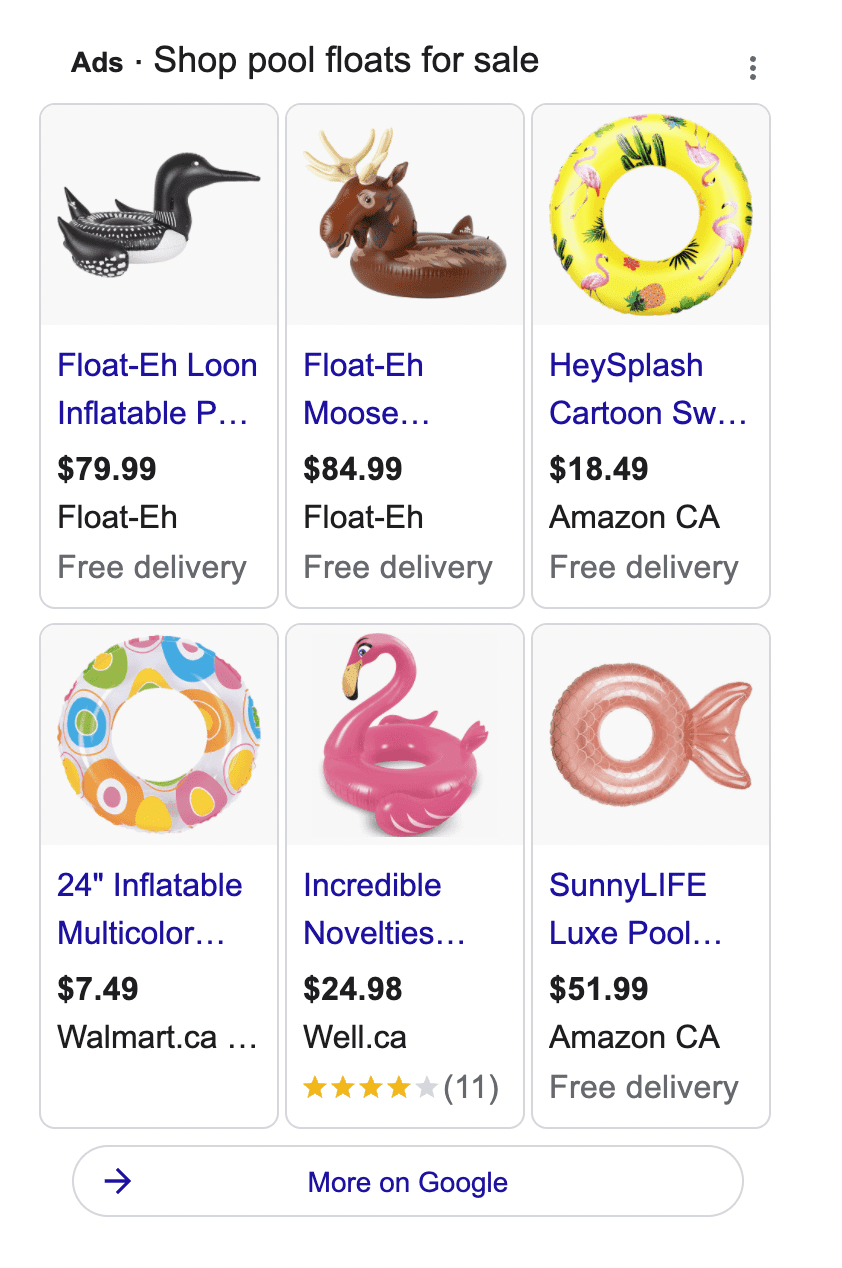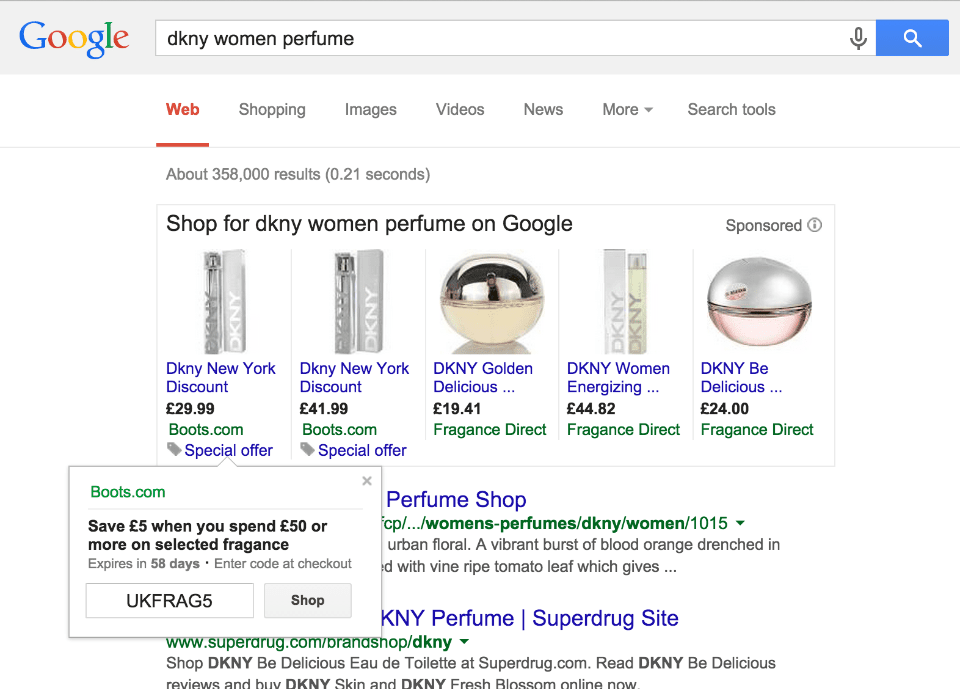When you’re looking for a product to buy, what’s the first thing you do? You Google it. And for most shoppers, the first result they see is the paid advertisement at the top of Google’s search results.
These product listing ads (PLAs) are like a miniature ecommerce store, complete with images of the product, prices, ratings/reviews, and other helpful information—all the stuff you want to know before you buy. Pretty nifty, huh?

So when you’re in the market for a new book or pair of shoes, instead of clicking on a plain old text link to Amazon or eBay, you’ll see a product listing ad at the top of your search results.
With product listing ads, you can provide shoppers with the major product deets to increase their chances of buying. Here’s how product listing ads can give your advertising strategy a boost.
What are Product Listing Ads?
PLAs are ads that appear in product-query searches on Google. These ads are highly targeted and tailored to your search, and they allow you to click through to purchase a product directly. PLAs effectively drive sales to the product listings and have been found to generate the most ad revenue per click.

But How Do They Work?
It works like this: When a user searches for information about a product on Google, PLAs show in the results at the top or left side, in the shopping tab, or the images tab. The ads feature an image of the product and pertinent information, such as price and product description.
When you click on a product listing ad, you’ll be taken directly to the product page with all the details you need to know before making a purchase.
Unlike standard ads, you don’t have to list every keyword. You simply create a product feed, an organized list of your products. Then, Google automatically pulls information from your feed, including product information, images, and prices.
How can you keep track of everything? Well, Google Analytics already does the work for you. Once you add your product listing ad’s Google Merchant Center product feed to your Analytics account, the system will track each visit to your site. You can set a daily budget for your PLAs to control how much you spend on the product ads.
Why Should You Use Product Listing Ads?
PLAs are an excellent way to attract qualified traffic for your products. Visitors who click on your ads are more likely to purchase your product because they’re already in the shopping mindset. Some other reasons to consider using PLAs include:
- Increased reach: Using product listing ads gives you Google real estate, giving your brand more exposure. That means you’ll get your product in front of more potential eyeballs than ever before. This can lead to an increase in sales and brand awareness.
- Higher click-through rate: According to Google, PLAs have a higher click-through rate than other ad formats because all the most essential information on the product is upfront. With a higher CTR, you’re able to drive more traffic and conversions to your product listings with PLAs compared to using other formats.
- Lower costs: Since product listing ads have a higher CTR than other ad formats, you can expect your CPC to be lower. Lower CPCs mean lower costs, and that’s never a bad thing.
How to Optimize Your Product Listing Ads
Product listing ads features include a headline, image, and product data. Sometimes they could also have a type of enhancement. Here is a basic overview of each of these features.
Headline
Use a descriptive and enticing headline, as it will be the first thing customers see when they click on your ad. This is also the only place you can use up to around 150 characters (but only 70 characters are actually displayed—see cut-off headlines below). Use your most compelling keywords here, but don’t try to lure customers in with slick language. (Tip: Use a keyword search tool for inspiration).

To keep it clean and simple, PLAs only display the product’s name and a price—no fancy jargon allowed! Don’t forget to add your brand name to your title to leverage any name recognition your brand may have.
Image
High-quality images of the product you’re advertising will help customers feel more confident about clicking the ad. Make sure your product images are clear to help customers get a better look at them.
Pick your pictures wisely to represent your products accurately. Photos should be 100 x 100 pixels at a minimum (250 x 250 for apparel products), max 16MB.
Product data
This section is where you list out your product’s vital stats: price, brand, color, size, material, and other product details. Make sure to include as much detail as you can to help steer customers in the right direction.
No one likes a bait-and-switch. Avoid displaying inaccurate or misleading information about your products. If you do, you might get in trouble with Google.
Enhancements
Show promotions and customer reviews in your ads to increase engagement. These won’t be displayed all the time, but they may increase the likelihood of someone clicking on your ad.

Get Your PLAs Ready
Product listing ads are an incredible way to get more exposure for your ecommerce site. They can be a great source of revenue if you use them correctly. If you’re new to PLAs, go ahead and give them a try. Make sure to track your conversions carefully so you can see how they affect your bottom line.
One last thing: Make sure your site is optimized for mobile viewing. Google reports that PLAs are most likely to be clicked on mobile devices, so you don’t want to miss out on mobile traffic by neglecting your mobile optimization. Your mobile landing page better be ready for those post-clicks, and that means it should be easy to navigate with clear copy and able to load quickly.

![[General] CI Conversion Intelligence Platform](https://unbounce.com/photos/blog-visual-cta-bofu-2260x1217-1.png)
